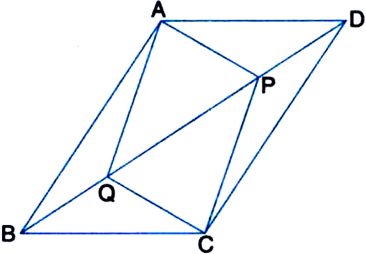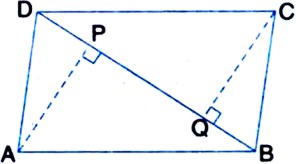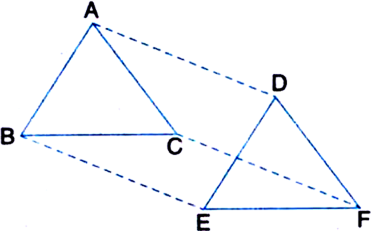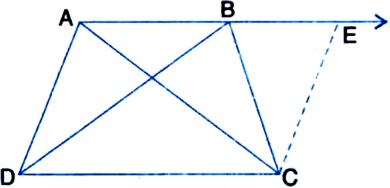Circles
ABCD is a trapezium in which AB || CD and AD = BC (see figure): Show that
(i) ∠A = ∠B
(ii) ∠C = ∠D
(iii) ∆ABC = ∆BAD
(iv) diagonal AC = diagonal BD.
[Hint. Extend AB and draw a line through C parallel to DA intersecting AB produced at E.]
Given: ABCD is a trapezium in which AB || CD and AD = BC.
To Prove: (i) ∠A = ∠B
(ii) ∠C = ∠D
(iii) ∆ABC ≅ ∆BAD
(iv) diagonal AC = diagonal BD. Construction: Extend AB and draw a line
through C parallel to DA intersecting AB produced at E
Proof: (i) AB || CD | Given
and AD || EC | By construction
∴ AECD is a parallelogram
| A quadrilateral is a parallelogram if a pair of opposite sides are parallel and are of
equal length
∴ AD = EC
| Opp. sides of a || gm are equal
But AD = BC | Given
∴ EC = BC
∴ ∠CBE = ∠CEB ...(1)
| Angles opposite to equal sides of a triangle are equal
∠B + ∠CBE = 180° ...(2)
| Linear Pair Axiom
∵ AD || EC | By construction
and transversal AE intersects them
∴ ∠A + ∠CEB = 180° ...(3)
| The sum of consecutive interior angles on the same side of a transversal is 180°
From (2) and (3),
∠B + ∠CBE = ∠A + ∠CEB
But ∠CBE = ∠CEB | From(1)
∴ ∠B = ∠A
or ∠A = ∠B
(ii) ∵ AB || CD
∠A + ∠D = 180°
| The sum of consecutive interior angles on a same side of a transversal is 180°
and ∠B + ∠C = 180°
∴ ∠A + ∠D = ∠B + ∠C
But ∠A = ∠B | Proved in (i)
∴ ∠D = ∠C
or ∠C = ∠D
(iii) In ∆ABC and ∆BAD,
AB = BA | Common
BC = AD | Given
∠BC = ∠BAD | From (i)
∴ ∆ABC ≅ ∆BAD.
| SAS Congruence Rule
(iv) ∵ ∆ABC ≅ ∆BAD
| From (iii) above
∴ AC = BD. | C.P.C.T.
Sponsor Area
Some More Questions From Circles Chapter
ABCD is a rectangle in which diagonal AC bisects ∠A as well as ∠C. Show that (i) ABCD is a square (ii) diagonal BD bisects ∠B as well as ∠D.
In parallelogram ABCD, two points P and Q are taken on diagonal BD such that DP = BQ (see figure). Show that:

(i) ∆APD ≅ ∆CQB
(ii) AP = CQ
(iii) ∆AQB ≅ ∆CPD
(iv) AQ = CP
(v) APCQ is a parallelogram.
ABCD is a parallelogram and AP and CQ are perpendiculars from vertices A and C on diagonal BD respectively (see figure). Show that:
(i) ∆APB ≅ ∆CQD
(ii) AP = CQ.
In ∆ABC and ∆DEF, AB = DE, AB || DE, BC = EF and BC || EF. Vertices A, Band C are joined to vertices D, E and F respectively (see figure). Show that:
(i) quadrilateral ABED is a parallelogram
(ii) quadrilateral BEFC is a parallelogram
(iii) AD || CF and AD = CF
(iv) quadrilateral ACFD is a parallelogram
(v) AC = DF
(vi) ∆ABC ≅ ∆DEF. [CBSE 2012
ABCD is a trapezium in which AB || CD and AD = BC (see figure): Show that
(i) ∠A = ∠B
(ii) ∠C = ∠D
(iii) ∆ABC = ∆BAD
(iv) diagonal AC = diagonal BD.
[Hint. Extend AB and draw a line through C parallel to DA intersecting AB produced at E.]
In a parallelogram, show that the angle bisectors of two adjacent angles intersect at right angles.
If a diagonal of a parallelogram bisects one of the angles of the parallelogram, it also bisects the second angle and then the two diagonals are perpendicular to each other.
Mock Test Series
Sponsor Area
NCERT Book Store
NCERT Sample Papers
Sponsor Area